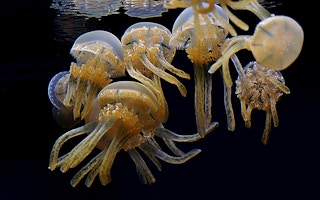So why do oceans matter, and how can they be protected?
Why is ocean conservation important?
The world’s oceans play a major role in the global climate - providing oxygen that sustains human and animal life, driving weather systems and storing about a quarter of the planet-heating carbon dioxide (CO2) generated by human activities.
“It makes this planet habitable,” said Liz Karan, who leads high seas protection work at the Pew Charitable Trusts.
“They say that every second breath you breathe comes from the ocean,” she said.
The ocean also supports a huge range of biodiversity, including potentially millions of species that humans have not discovered yet.
But according to the Red List of Threatened Species from the Swiss-based International Union for Conservation of Nature (IUCN), nearly 10 per cent of underwater plants and animals assessed so far are threatened with extinction.
How are oceans being damaged?
The biggest driver of environmental decline in the ocean has been from “indiscriminate” fishing, said Jessica Battle, a senior expert on ocean policy and governance at the World Wildlife Fund (WWF).
This not only depletes fish stocks but erodes the ability of their populations to rebuild, she said, and many fish are accidentally caught and later discarded as waste - so-called bycatch.
According to estimates, bycatch accounts for about 40 per cent of the world’s global commercial catch.
Pollution is another major cause of harm, including plastics, sewage, and excess nutrients which wash from the land to create “dead zones” in the ocean by causing an overgrowth of bacteria on the sea floor that uses up oxygen and suffocates other life, Battle said.
At the same time, climate change is also hitting ocean health - causing coral reef bleaching and forcing fish to migrate to cooler waters.
“
[Oceans] make this planet habitable. They say that every second breath you breathe comes from the ocean.
Liz Karan, senior manager, Pew Charitable Trusts
What percentage of oceans are protected?
During UN talks in December in Montreal, countries agreed a landmark deal to slow and reverse biodiversity loss, including a target to protect 30 per cent of the world’s lands and seas by 2030.
Conservationists hope the nature pact can provide momentum to agree an oceans treaty, as the global “30 by 30” goal will likely be unattainable without protecting the high seas.
Currently, 8.16 per cent of marine areas are protected globally which includes 1.44 per cent of the high seas, according to the latest figures from the IUCN.
High seas areas that are protected include parts of the North East Atlantic and Antarctic oceans, but because the protection accords are regional rather than global, they do not bind all governments, Battle said.
Are marine protected areas effective?
Marine protected areas (MPAs) help preserve nature by prohibiting certain activities such as fishing, and several scientific studies have shown that well-enforced MPAs increase the number and diversity of species in the areas and beyond.
“If there is greater abundance of marine life within those areas of protection, they have spillover effects because MPAs don’t have closed borders,” said Karan from Pew.
However, she said their effectiveness hinges on having management plans in place to ensure enforcement, which includes the use of tools like high-resolution satellites.
The high seas treaty being negotiated in New York would fill a “gap” by creating a legal mechanism to establish protected areas in the high seas, Karan said.
“The real test will be creating those high seas protected areas and making sure that they are highly and fully protected from extractive activities,” she said.
This story was published with permission from Thomson Reuters Foundation, the charitable arm of Thomson Reuters, that covers humanitarian news, climate change, resilience, women’s rights, trafficking and property rights. Visit https://www.context.news/.

















